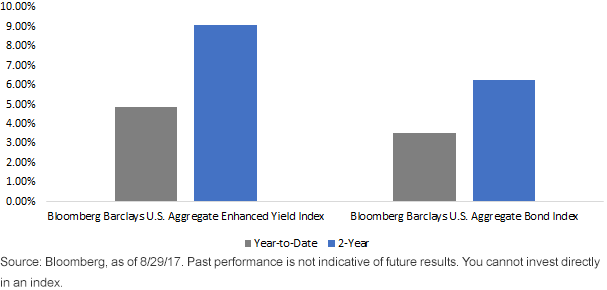
The U.S. interest rate backdrop continues to remain challenging for investors looking for income. The rise in U.S. Treasury (UST) yields following last November’s Election Day, and a bit more recently around the Federal Reserve’s (Fed) first rate hike in 2017, allowed investors to possibly believe that rates may finally be making a more permanent move higher. Or, at the very least, that yield levels had finally bottomed and a new and elevated trading range had been established.
That was then; what about now? I’ve written a number of times about the current U.S. rate backdrop and what may be in store for the remainder of this year and into 2018. The more important question is, how do fixed income investors position their portfolios to try and enhance income without taking on too much credit and/or duration risk?
Index Returns

The traditional approach for fixed income investing has been to follow the market cap-based strategy, where the amount of debt outstanding is the focus for sector weighting. This is the approach utilized by the widely followed Bloomberg Barclays U.S. Aggregate Bond Index (Agg). The major sectors within the Agg are Treasuries, investment-grade (IG) corporates, agency securities and securitized products such as mortgage-backed securities. As the U.S. budget deficit ballooned to record levels in excess of $1 trillion during the 2009–2012 period, Treasury issuance skyrocketed to finance this gaping hole. As a result, the Agg has seen a dramatic shift in its weighting to Treasuries, going from a little over 20% to its current reading of nearly 38%. Consequently, this shift subjects fixed income investors to sacrificing income and heightened rate risk at the same time.
Is there an alternate approach that fixed income investors should consider? The Bloomberg Barclays U.S. Aggregate Enhanced Yield Index (AEY) is a rules-based smart beta approach that seeks to improve upon the counterintuitive features of the market cap-based strategy. By reweighting the sectors of the Agg, the enhanced yield strategy attempts to boost income while still maintaining a familiar risk profile. AEY employs guardrails such as a weight constraint, +/-20% by major sector, and a duration cap of +1 year. This strategy generates over-weights in IG credit and under-weights in Treasuries. It also comes in a “short-term” version for investors who wish to mitigate the potential for higher rates. The guardrails in this case are: weight constraint by major sector +/-30%, duration cap +.5 years.
















